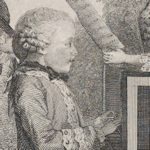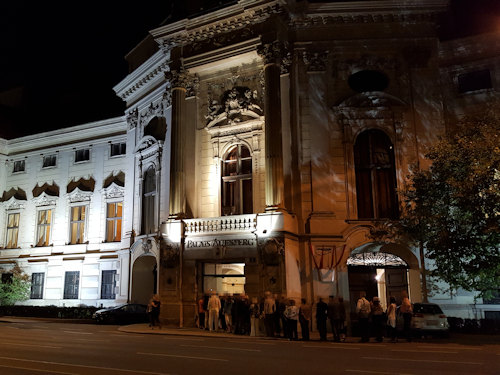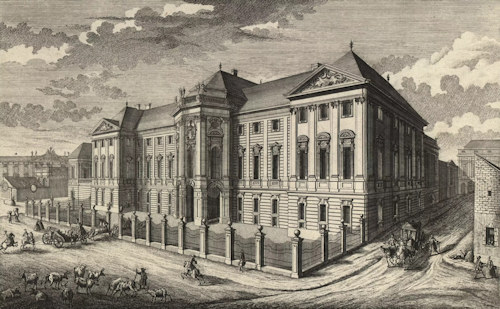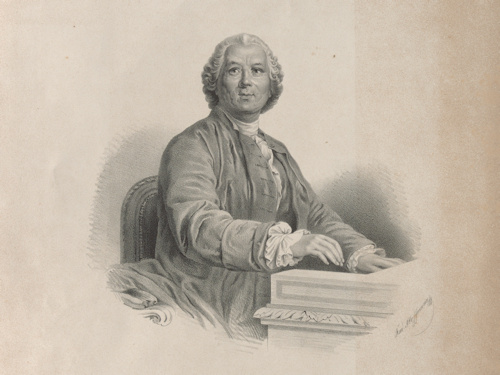
This beautiful building from the early 18th century once hosted works by Mozart when the ink on the sheet music had only just dried. Palais Auersperg remains one of Vienna’s Baroque jewels.
- Originally built in 1710
- Strong musical connections to the likes of Mozart and Gluck
- Used as an event location in modern times
- Book a concert experience* for Vienna
- See also:
- Concert venues in Vienna
- Baroque Vienna
- Mozart locations
A Baroque palace

(Queueing for a concert at the palais)
Palais Auersperg began life around 1710 as Palais Rofrano. The change in name came about toward the end of the same century following the building’s purchase by Prince Johann Adam Auersperg.
At one point, the palais fell into disrepair, but coffee magnate Alfred Weiss (subject of a 2022/2023 exhibition at the Jewish Museum) bought the premises in the mid-1900s and had them turned back into an architectural delight and society hotspot.
Today, the palais is one of many gorgeous historical buildings in Vienna not open to the public as such. Instead, it’s most recent use has been as a private event location for congresses, fairs, balls, galas and more.

(Palais Rofrano as Palais Auersperg was then known, around 1725; drawn by Salomon Kleiner, engraved by Johann August Corvinus, and published by Johann Andreas d. Ä. Pfeffel; Wien Museum Inv.-Nr. 15694; excerpt reproduced with permission under the terms of the CC0 licence)
Mozart, Gluck and WWII
Like many city townhouses, Palais Auersperg played its particular part in Austrian history.
Emperor Franz Joseph and Empress Elisabeth danced here, for example, and one of the leading groups in the Austrian freedom fighter movement met inside as World War II drew to a close.
On the music side, a former occupant – Field Marshall Joseph von Sachsen-Hildburghausen (1702 – 1787) – was a patron of Christoph Willibald Gluck.
The Field Marshall employed Gluck as Kapellmeister (musical director) for several years. And we know that in 1786, for example, Palais Auersperg hosted at least one performance of Mozart’s opera, Idomeneo.
We can’t be sure, but it seems very likely that Mozart would have graced the occasion with his presence. It’s more certain, however, that he made alterations to the work specifically for the palais production.
Those were the days when formal concert venues like the Musikverein did not exist. Instead, musical performances often took place in the private homes of the rich and aristocratic.
(A little like Beyoncé penning a new song and then turning up at your house to give a rendition.)
The names of one or two rooms reflect this musical connection. The Rosenkavaliersaal, for example: they say one of the main characters in Richard Strauss’s opera, Der Rosenkavalier, took its inspiration from the family who first built Palais Auersperg.

(A lithograph of the composer Christoph Willibald Gluck by Rudolf Hoffmann, printed by Joseph Stoufs and published by F. Paterno around 1850–1860; Wien Museum Inv.-Nr. W 2209; excerpt reproduced with permission under the terms of the CC0 licence)
Until recently, the Vienna Residence Orchestra kept the tradition of live music going with regular evening performances. The orchestra has since moved to other palais locations, most notably the lovely Old Stock Exchange.
How to reach Palais Auersperg
The palais is quite central and very close to such sights as the parliament building, the Rathaus, and the Museumsquartier (so not hard to find).
Subway: the nearest station is Volkstheater on the U2 and U3 lines. Take the station exit leading away from the city centre and walk up Museumstraße
Tram/bus: the Auerspergstraße tram stop sits more or less at one end of the building and is served by the 46 tram line.
Address: Auerspergstraße 1, 1080 Vienna